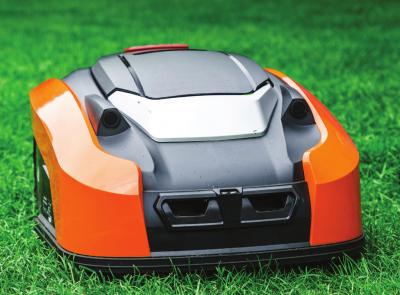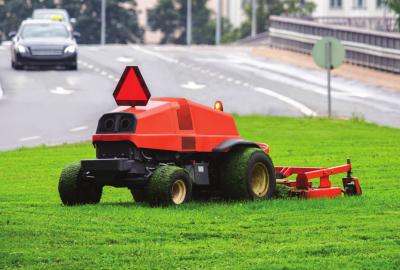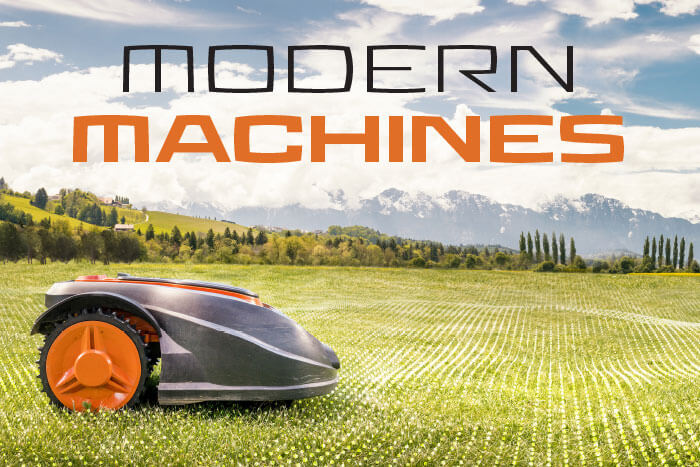As robotic and automated mowing options became available to green industry professionals several years ago, it wasn’t certain how they would affect everyday workers. Now that contractors have had some time to work with the technology, it’s easier to see them as another tool that can improve business when used correctly.
Joe Langton, owner of Automated Outdoor Solutions in Woodstock, Illinois, started researching automowers in an effort to make his landscaping services more efficient to match the snow removal services his company offered. He remembers first seeing an autonomous model at an industry conference several years ago. While others around him were dismissive of the prospect, he immediately began working the numbers of what it cost him to mow per acre with a human compared to this machine.
“I took the information from the show and did some calculations and said, ‘OK, these things could work,’” he says.
Now he’s so involved in the technology that he runs a podcast talking about what he’s learned in the process.
Eric Cross, president of Duke’s Landscape Management Inc., Hackettstown, New Jersey, has pushed for the company to be involved in a peer group that has been focused on technological advances for mowing for years. “We’re really big on taking advantage of the latest technology,” he says. “It’s been a nonstop learning experience for me.” For him, watching the strides that manufacturers have made since the concept became popularized, “I feel like I’m watching history being made, like watching us land on the moon.”
Michael Mayberry, chief technology officer for Level Green Landscaping, Upper Marlboro, Maryland, recognizes that it might not seem common to many for a role like his to exist at a landscaping firm. “As you look around the industry, you aren’t seeing companies that have a CTO or director of technology,” he says. “That’s what I’m trying to do for Level Green, is to keep us on the cutting edge.”
Test the tech
Langton started out by purchasing five units and placing them at his house and with some key employees.
“That way, if it was a failure, it was no big deal,” he says. “For every landscaper or irrigation contractor, that’s what I would urge. You don’t have to go crazy with it. You can just start simple.” Working directly with the technology let him get more familiar with what he and his team liked and disliked about it, which has also better prepared them to talk with customers.
Even if you aren’t looking to incorporate some kind of autonomous or robotic mower into your fleet, it’s important to stay on top of developments. Companies that treat them like a fad “won’t be able to compete once enough companies have really switched to this,” says Mayberry. “If you’re not ready to do it, that’s completely understandable. But keep a close eye on it.”
If you’re feeling paralyzed by the options on the market and the jargon surrounding them, start by finding someone in your company or a consultant who has a passion for interacting with technology who can explain it to you, he says. Even if it’s not the right time for you to move forward with it, you need to be ready for when that time comes around.
Finding an anchor person in your crew to dig into the options can go a long way toward bringing the rest of the team on board as well.
“Look at who on your crew would find this something enjoyable, to just watch technology blossom right in front of your eyes,” Cross says.
Be ready to make an investment of time as you add robotic or autonomous mowers to your fleet, as both you and your team will need to learn how best to use them. “Each week that we go, it gets more and more efficient,” says Cross.
Don’t wait for a new technology to come along that will promise to do everything because you’ll never make the jump. “That’s a pitfall,” Langton says. “There’s nothing else in the industry that’s a 100% solution, right? They’re never going to have something that does everything.” It’s also important not to think of a smaller machine as necessarily less effective, as it can mow at a steady pace and in off-usage hours. Larger mowers are more needed for human operators who need to get through as many yards as possible along a route as quickly as they can to improve margin.
Don’t think of adding autonomous technology to your fleet as a one-time switch, but rather finding the right pace to fill in gaps over time. “It’s about feathering in the technology over the next five to 10 years,” says Mayberry. “It’s never a point of saying, ‘OK, tomorrow we’re switching to all robotics.’”
Instead, it might make more sense to work with partners or peer groups to see how autonomous mowers are working for them. “There are lots of ways to be a part of the early stages without having to invest in the early stages,” says Mayberry.
Mayberry’s journey into robotics began several years ago, and he’s worked with multiple manufacturers to try out different forms of technology. “There’s a lot of options out there, and I think it’s worthwhile to explore all of those.” Keep in mind that what works for one company might not work for your situation.
Connect with clients
Client education plays an even more important role with robotics and autonomous mowers than with many other landscaping services. Make sure you have a solid understanding of what you’re offering before taking it up with a client, because they’ll likely have many questions right from the start, Cross says.
“The first question I get is, ‘Is it safe?’ It’s very safe,” he says. Seeing how the mowers operate and the level of control available to the technician, especially if the client is concerned about obstacles entering the mower’s path, can make a big difference.
 Early in his work with robotic mowers, Mayberry looked for clients that could benefit from the kind of service provided by those machines. He partnered with a local monastery to install two units there and with a private school to have one of the mowers handle the sports fields.
Early in his work with robotic mowers, Mayberry looked for clients that could benefit from the kind of service provided by those machines. He partnered with a local monastery to install two units there and with a private school to have one of the mowers handle the sports fields.
“We had to make sure that somebody could get to that site two to three times a week in order to mow it and maintain that look that the school was expecting,” he says. With the robotic mower, he was able to take both the reel mower and dedicated technician off that project, saving a large amount of time. “Now the field presents itself at its optimal level all the time because it just keeps mowing. That’s a huge benefit for us.”
Look for clients that need a clean, consistent look; a sports field could be a good candidate, he says. A wide open area with few obstacles that needs maintained can be helpful as well. Mayberry now uses both locations as case studies to deploy the mowers with additional clients.
A large, flat topography, similar to a soccer field, isn’t required, but can be helpful in showing off how robotic mowers can add efficiency, says Cross. It’s also important to look for clients who would be interested in the ways that an autonomous mower can add benefits through specific applications, such as mowing at night.
Langton took a different approach by reaching out to past clients who had fired his company because of issues with operations such as blowing too many clippings into mulch beds. He suggested that they let him place a robot on the property instead.
“To my surprise, more than half of the people I called said yes,” he says. “They understood that when they fired us and went with somebody else, they had the same problem.”
For current and new customers that he offers the service to, he pushes for an extended contract of at least four years to make it more cost-effective. That’s worked out for him as clients are often eager to lock in a price over time. In his contracts, he’ll install the robot and if the customer ends up not liking the service, all they pay for is the installation itself.
“I think that’s where the industry is going to have its biggest hurdle,” he says. “In order for the landscaper to really make money with these, you need to be able to make them last five years.”
Finding the right clients to set up as early adopters of the service can open up new opportunities, Mayberry says.
“If you do good installs in great locations, then those clients are going to be evangelists for you and for the technology,” Mayberry says. “The last thing we want is clients getting the impression that this technology is not going to provide the consistent quality that they expect.”
At Duke’s, Cross calls out the new technology in presentations to new clients as a way to prove that his team is always looking for ways to do work more efficiently and save the client money, he says.
Just having the machines on-site can do some of the legwork for you as well, as visitors to the field or yard will spot the new technology and begin talking about it. “You want to generate some conversation about it so people will start asking questions,” Mayberry says. For his homeowner association customers, he’s pushed to place a mower at the entrance so visitors understand how the lawns are cared for.
That visibility can not only start people talking but make clients more comfortable with the concept. “We have a large corporate campus that has a five-man crew five days a week,” says Cross. “That’s one of the ones that has a machine full time. At lunchtime, people do their lunch walk and they’ll see the machine going.”
The client’s employees have gotten used to saying hello to the mower as they pass it, and have named it Dexter, he says.
Empower your crew
One of the biggest concerns for many contractors looking into robotics is how it interacts with labor. “It is going to disrupt the industry,” says Mayberry. “Everyone complains about labor, and it’s not just from COVID. That shined an extra bright light on it, but we’ve had these issues prior.” Robotics allows a forward-thinking company to be less reliant on local hires to maintain stability and to rearrange to maximize value.
There can be a definite “us vs. them” mindset for crews wary of robotic and autonomous mowers taking over jobs, says Mayberry.
 “Robots are not replacing our humans,” Mayberry says. “They are giving us a chance
“Robots are not replacing our humans,” Mayberry says. “They are giving us a chance
to do more with the human beings that we have. Rather than our humans just mindlessly mowing in the middle of a field, we can have those humans focus on the detail work.”
Cross uses mainly three-person crews on his routes, but when there’s a robotic mower on the property, he’s able to shift to a two-person crew format. Now he has two people trimming, blowing and doing detail work. “They’re keeping an eye on the mower,” he says. As he brings on more in the next year, “that’s more crews I could put out with the same amount of labor. That really lets me generate a lot more revenue.”
Langton trains his employees to think of themselves as a bridge between the customer and the technology. When a robot gets stuck on something in the yard, his crew will come out and reset it.
“Even though the customer is dealing with less people, they’re still dealing with people,” Langton says. “The only thing that’s changed in my models is that instead of having three people show up to an account is that there’s typically only one or two now.”
Incorporating a robot allows Mayberry to continue looking for company growth despite attrition in workers and allows him to better pay the humans who are on staff and learning new techniques. “Their skill set will evolve from where we don’t need people who just go sit on a mower,” he says. “We need someone who understands when to prune a plant.”
For Langton, reducing mowing as an assigned job has allowed him to provide different opportunities for his employees, sometimes finding a better fit for them in irrigation or construction projects. The crew members who are used to doing the detail landscaping work often are good choices for route supervisors because they know what needs to be handled alongside the robot.
Cross’s crew is excited for the possibilities presented by robotics, especially as they’ve started to work alongside them.
“We’re always looking to improve, to learn,” he says. “This is just another tool in the toolbox now.”
Robotic mowers will also create new jobs entirely involving technicians who know how to efficiently manage them and keep them running correctly.
“When we have 150 robotic mowers, we’re going to have somebody sitting behind a desk with three screens and an Xbox controller deciding when these mowers should cross the road. That’s definitely not a job people are thinking about in the landscaping industry at this point,” Mayberry says. That gives industry professionals the opportunity to attract people from different labor pools than in the past.
Direction of autonomous mowers is one option, but maintaining them will open up new job opportunities as well. Langton has a background in small circuitry, giving him the skill to make repairs, but he expects to be hiring more with that skill set soon to help keep the mowers running long past a few years, as with more traditional mowers.
The new technology has led to additional hires for Cross, as a way of showing that working at Duke’s means staying on the cutting edge of the market.
“People want to work for a place where they feel like there’s things happening, there’s learning,” he says. Instead of just a daily grind, a focus on technology provides new angles from which to see the landscape industry for potential hires. “You can’t just have old trucks and old mowers. You’ve got to enjoy the people you’re working with and it has to be a learning experience.”





